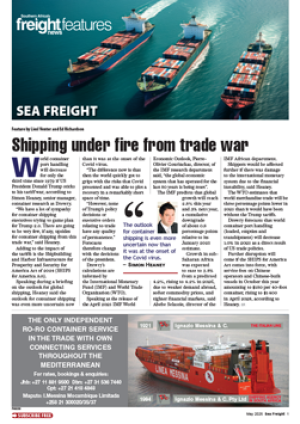The Beira Corridor is set for growth as volumes out of the Democratic Republic of the Congo (DRC) continue to increase.This was good news for logistics companies servicing the corridor, said Kevin Hutton, general manager of Beira Logistics Terminals (BLT).“Export cargo out of the DRC is growing. Logistics companies are under pressure to create capacity, and investment into f leets and warehousing is ongoing,” he told Freight News.“Also, looking at the statistics for the Beira port, we can see that volumes are growing year on year. Our biggest challenge in the logistics supply chain is not to be caught on the back foot.”He said often, when volumes were up capacity was down, with not enough transporters to service the corridor – as was currently the case. The reverse, however, was also problematic as too much capacity and not enough volume was not cost-effective either.“When the global pandemic broke out we saw a major increase in the number of transporters operating on the Beira Corridor and rates were pushed down significantly. This was one of the few corridors that continued to operate and there was a lot of interest,” he explained. “More recently we had major capacity available on the corridor as no stock was coming in and trucks were standing. Now we have the reverse – there is not enough capacity to service the growing volumes.”According to Chris Morris, general manager of Specialized Transport, even if more trucks could be found it is not as simple as just increasing the number of vehicles on the corridor as this would only exacerbate the bottlenecks and congestion that already exist at border posts.“Border posts like Machipanda between Zimbabwe and Mozambique are simply too small for the sheer volume of cargo we are seeing coming out of the DRC,” he said. “It is a single-lane border post and there is no physical space for expansion. It is just gridlocked and putting more infrastructure in will be difficult.”He said transporters were conscious of these restrictions and made every effort to give agents advance notice of arrival. “We do as many pre-alerts as possible in an effort to alleviate the pressure on the border and to reduce any delays.”Hutton and Morris said it was essential to have integrated systems in these times, with an emphasis on collaboration. “It is incredibly important to plan and to ensure everyone is on board to keep the inevitable delays to a minimum,” said Morris.Another ongoing challenge was the deterioration of infrastructure. In Mozambique, the EN1 linking the north and south was one example of this. Over the past three to four years this road has deteriorated to a non-repairable state. “There is an urgent requirement for a complete new road build,” said Morris. “There are various bridges not able to carry necessary project and oil and gas cargo north to south and vice versa due to f looding and lack of continuous maintenance.”The lead times for cargo moving on sections of this road had increased significantly and in many cases loads were diverted via Zimbabwe. Border post congestion has long been a challenge in southern Africa. “It is not unheard of to wait several days at a congested border post with trucks released in batches,” said Morris. “From our side, we have put in place numerous systems and processes that give us a much clearer picture of where the bottlenecks are on the corridor and what to expect.”Hutton said it was also essential to provide integrated solutions between transport and warehousing in Mozambique. “With our different business units, and our presence in all the countries along the route, we have been able to streamline our operations in and out of the DRC.”Morris agreed, saying with yards and workshops also set up along the route any challenges or issues could easily be sorted out, allowing for an efficient f low of cargo.“No doubt there are challenges on our corridor, but the bigger picture is very positive. Volumes are growing and demand is on the increase,” he said.“With mining on the increase in Africa, and the world hungry for minerals, we are very positive about the future and the growth of the Beira Corridor,” concluded Hutton.

